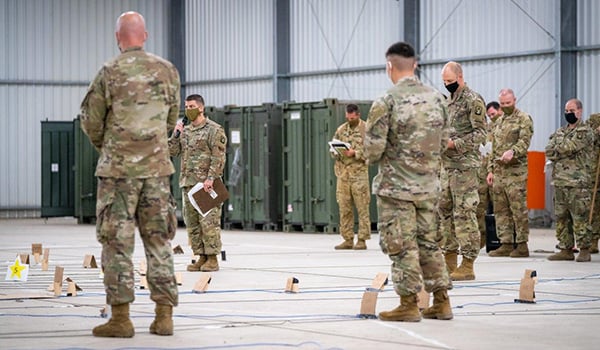
Branch Chief’s Corner / By MG David J. Francis: Current and emerging threat capabilities provide our adversaries stand off from U.S. and coalition forces, which sets the basis for U.S. Army and Joint Force discussions on Multi-Domain Operations.

12th Combat Aviation Brigade staff members brief battle plans during a combined arms rehearsal for Saber Junction 20, Aug. 5, at Hohenfels, Germany./ U.S. ARMY PHOTO BY MAJ ROBERT FELLINGHAM
Our consensus on how we will fight across all domains, drives the U.S. Army modernization strategy to give us the ability to penetrate, dis-integrate the Integrated Air Defense Systems (IADS) and Integrated Fire Control (IFC), exploit the freedom of maneuver and return to competition on terms more favorable to U.S. and coalition forces.
Survivability results from a combination of Aircraft Survivability Equipment (ASE), Tactics Techniques and Procedures (TTP) and fighting as a combined Arms Team. This methodology insures the survivability of aviation assets as well as other members of the Combined Arms Team.
The Enemy
Everything we do tactically, operationally and strategically, is driven by the threat. We have phenomenal people and agencies across DOD, and many other entities that focus on identifying and understanding the functionality of enemy systems and how they are arrayed against us. We clearly recognize that the enemy continues to take detailed notes about how we employ and fight over the past dozen years plus. Even though that fight was not Large-Scale Combat Operations, our adversaries realized that they need to create a buffer zone – standoff – against us at every level. Their primary standoff against the Army Aviation force is a modernized version of the Cold War era concept of Integrated Air Defense System (IADS) and the reintroduction of Radio Frequency (RF) systems. However, the same agencies that work to define the threat capabilities and tactics are the same ones who work hand in glove with our folks who create the requirements to modernize current aircraft and build new aircraft, specifically the Future Vertical Lift (FVL).
The Aircraft
As we design new aircraft and modernize the enduring fleet, there is always an abundance of discussion. Discussion about capabilities such as speed, range, maneuverability, payload, weapons systems, sustainability and numerous other areas were there can be tradeoffs in order to tailor an aircraft for a certain mission set the Army needs us to do. We always strive to build multiple layers of survivability into our aircraft so that they can face the many challenges our adversaries throw at us. However, no aircraft, or ground vehicle for that matter, can be invulnerable to every weapon system on the battlefield and still execute their mission. Within the survivability bin there has to be a very refined process to match systems to the most probable lethal threat to the mission.
The Training
While aircraft play a large part in survivability, understanding the enemy’s tactics techniques and procedures and then correctly employing the aircraft to frustrate the enemy’s efforts can only be accomplished through tough, realistic training. Training one crew in one aircraft can be complex, but in Large Scale Combat Operations we will not be flying operations in teams of two, but will be flying multi-company, battalion, and brigade level operations. To that end we are orienting how we train everywhere from home station to the combat training centers.
As we evaluate future threat systems, we know that we will adjust our flight profile and need to do this in a deliberate manner. A current example is the threat’s RF systems, by running high fidelity testing and countless hours of live testing, we developed Low Level Training Support Packages for the field which exploit weaknesses in the threat systems. Additionally, we implemented the Emergency Response Methodology, a training approach that that teaches crews to evaluate and react to emergencies when flying at low flight profiles in the grown clutter, all of this well help drive them be decisive in LSCO.
The most significant aspect of our training, like our fighting, is that we do not do it alone.
Combined Arms Operations
Large Scale Combat Operations in a multi-domain environment against a near peer is a significantly different approach to fighting than what we have been involved in the last two decades. To defeat a near peer threat our most capable tool is the Combined Arms Team, a force that is very familiar with synchronizing lethality across multiple domains. As a member of that team, Army Aviation has merged relevant TTPs and Aircraft Survivability Equipment (ASE) which not only equates to being a more dominate platform, but when combined with the other elements of the Combined Arms Team becomes an even more survivable and deadly system that will play a significant part in the fight on any battlefield – because winning matters.
Above the Best!
MG David J. Francis is the Army Aviation branch chief and commander of the U.S. Army Aviation Center of Excellence and Fort Rucker, AL.








